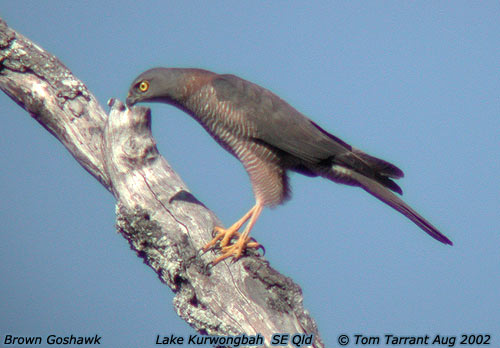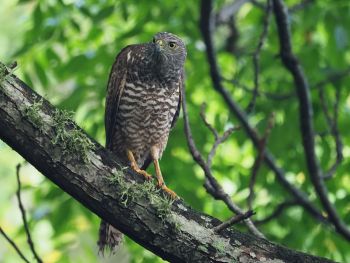Alternative name: Australian Goshawk
- Tachyspiza fasciata
Accipiter fasciatus
Includes: Christmas Island Goshawk
Identification
37-55 cm (14½-21½ in); tropical races smaller
- Grey or brown upperparts
- Brown head
- Rufous brown collar
- White underparts barred rufous
- Dark brown wings, buff below
- Grey dark barred tail
- Yellow legs
- Rufous thighs
- Yellow iris
Females larger
Juveniles
- Brown streaked plumage
- Grey brown iris
Similar Species
Distribution
Indonesia and Australasia. Breeds on Christmas Island and in the Lesser Sundas from Lombok to Sumba and Timor, the Moluccas, southern and eastern New Guinea, New Caledonia and Vanuatu and Australia. Occurs throughout most of the continent but scarce in the arid interior and on much of the central south coast. Also found on Tasmania and most coastal islands.
Nomadic or a partial-migrant in parts of Australian range with northward movements recorded, resident elsewhere.
Taxonomy
Subspecies
Twelve subspecies are recognized[1].
- T. f. natalis:
- Christmas Island (Indian Ocean) - may prove to be a full species, Christmas Island Goshawk
- T. f. tjendanae:
- Sumba (Lesser Sundas)
- T. f. wallacii:
- Lombok, Sumbawa, Flores and adjacent Lesser Sundas
- T. f. stresemanni:
- Tanahjampea, Kalao, Bonerate, Kalaotoa, Madu and Tukanbesi islands
- T. f. hellmayri:
- Lesser Sundas (Timor, Alor, Semau and Rote)
- T. f. savu:
- Sawu (Lesser Sundas)
- T. f. polycryptus:
- Eastern New Guinea
- T. f. rosselianus:
- Rossell (Louisiade Archipelago)
- T. f. dogwa:
- Southern New Guinea
- T. f. didimus:
- T. f. fasciatus:
- Australia, Tasmania, Solomon Islands (Rennell, Bellona) and Timor
- T. f. vigilax:
- New Caledonia, Loyalty Islands and Vanuatu
An additional subspecies buruensis, is not generally recognised[2].
Habitat
Open forest and woodlands from rainforest to dry scrubland. Often in riverine woodland.
Behaviour
Diet
The diet consists of small mammals, birds, amphibians, reptiles, arthropods and insects. They occasionally eat carrion.
Breeding
They build a stick nest lined with fresh eucalypt leaves. The eggs are incubated by the female.
References
- Clements, J. F., P. C. Rasmussen, T. S. Schulenberg, M. J. Iliff, T. A. Fredericks, J. A. Gerbracht, D. Lepage, A. Spencer, S. M. Billerman, B. L. Sullivan, M. Smith, and C. L. Wood. 2024. The eBird/Clements checklist of Birds of the World: v2024. Downloaded from https://www.birds.cornell.edu/clementschecklist/download/
- Gill, F, D Donsker, and P Rasmussen (Eds). 2022. IOC World Bird List (v 12.2) DRAFT. Doi 10.14344/IOC.ML.12.2. http://www.worldbirdnames.org/
- Avibase
- Handbook of the Birds of the World Alive (retrieved March 2016)
- Birds in Backyards
Recommended Citation
- BirdForum Opus contributors. (2025) Brown Goshawk. In: BirdForum, the forum for wild birds and birding. Retrieved 11 May 2025 from https://www.birdforum.net/opus/Brown_Goshawk
External Links
GSearch checked for 2020 platform.1








